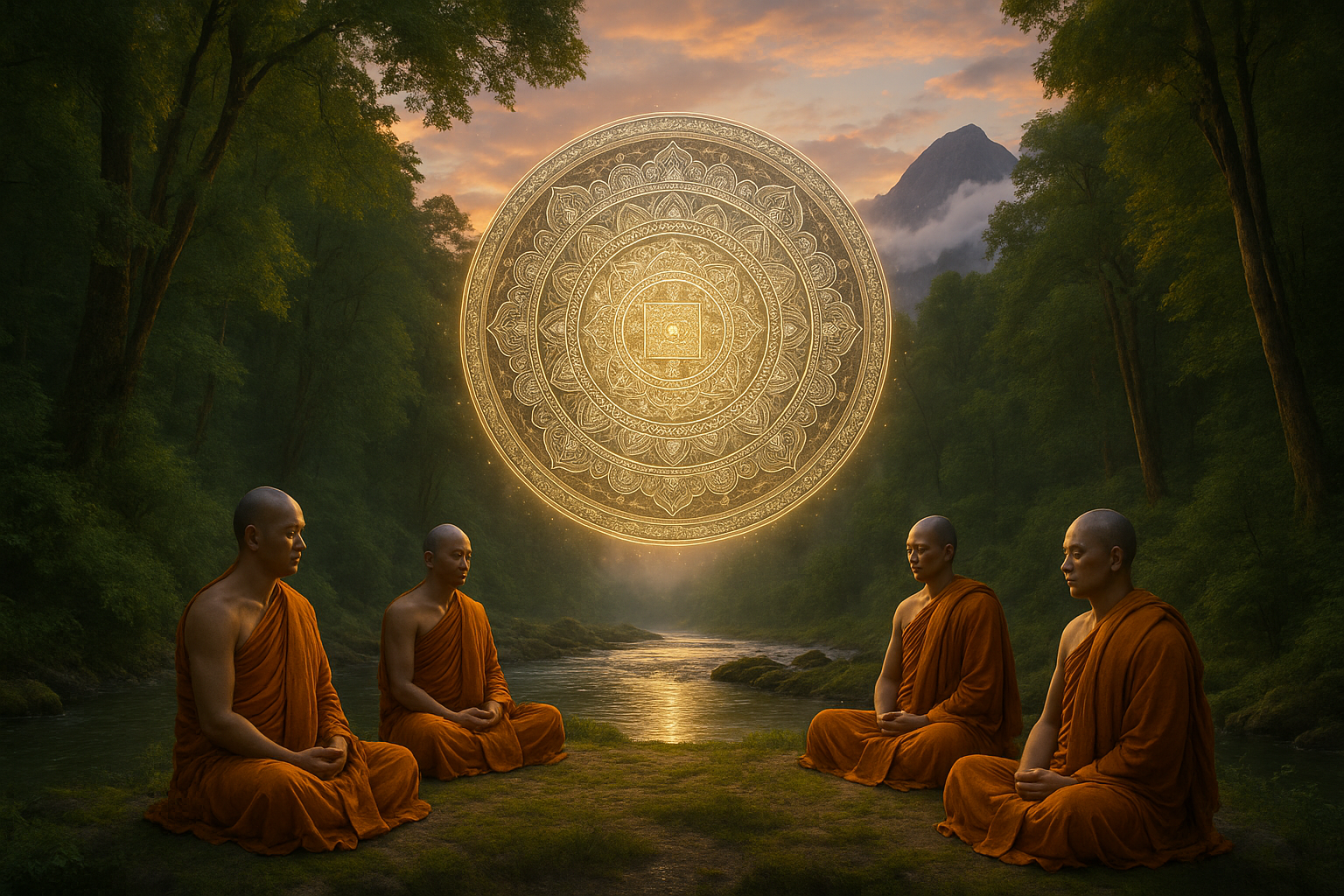In the vast tapestry of human belief systems, few are as intricate and fascinating as Buddhist cosmology. This rich tapestry weaves together profound philosophical ideas, mythical realms, and an understanding of existence that challenges the way we perceive our own reality. 🌌 The concept of endless cycles, known as Samsara, stands at the heart of this cosmology, offering a unique lens through which to explore the universe and our place within it.
Imagine a universe that is in constant motion, a wheel that turns perpetually with no beginning or end. This is the essence of Samsara, the cycle of birth, death, and rebirth. It’s a concept that invites us to ponder the mysteries of our existence and the nature of the universe itself. Unlike linear Western perspectives on life and death, Buddhist cosmology embraces the cyclical nature of life, encouraging us to explore what lies beyond our immediate perception.
As we delve deeper into this mystical worldview, we’ll uncover the layers of complexity that define it. From the Six Realms of existence to the intricate laws of karma that govern them, Buddhist cosmology is a profound system that challenges conventional thought. It invites us to question not only the world around us but our own inner workings as well. 🧘♀️
The Six Realms, each with its own unique characteristics and challenges, form the backdrop of this cosmic journey. They range from the heavenly realms, where beings enjoy great bliss and longevity, to the lower realms of suffering and despair. Understanding these realms provides insight into the Buddhist perspective on suffering and enlightenment, illustrating the diverse paths a soul may traverse through countless lifetimes.
At the core of this exploration is the law of karma. This universal law dictates that every action has a consequence, creating ripples that influence future existences. Karma is not merely a tool for moral judgment but a complex system of cause and effect that underscores the interconnectedness of all things. In our examination, we’ll explore how karma operates within the context of Buddhist cosmology, shaping the cycles of Samsara and influencing the journey of the soul. 🔄
Yet, the journey doesn’t end with understanding. The ultimate goal within Buddhist cosmology is to transcend these endless cycles and achieve Nirvana, a state of liberation and ultimate peace. The path to Nirvana is paved with understanding, compassion, and mindful practice. We’ll explore the teachings and practices that aim to guide adherents towards this enlightened state, highlighting the role of meditation, mindfulness, and ethical living.
Furthermore, we’ll draw parallels between ancient Buddhist cosmology and contemporary scientific theories. By juxtaposing these perspectives, we can gain a richer understanding of the universe and our place within it. This dialogue between science and spirituality opens up new possibilities for understanding consciousness, existence, and the very nature of reality itself. 🧬
Throughout this deep dive, we aim to not only elucidate the principles of Buddhist cosmology but also to inspire reflection on our own lives. How do we navigate our cycles? What lessons can we learn from this ancient wisdom to apply to our modern world? As we peel back the layers of Buddhist thought, we invite you to embark on this journey with us, to unlock the mysteries of endless cycles and perhaps, discover a new perspective on life.
# Unlocking the Mysteries of Endless Cycles: A Deep Dive into Buddhist Cosmology
Buddhist cosmology offers a fascinating insight into a worldview that is both ancient and profound. Unlike the linear progression often found in Western cosmological models, Buddhist cosmology is circular and cyclic, reflecting a universe in constant motion, without a beginning or an end. This perspective not only influences spiritual practices but also provides a unique framework for understanding existence and consciousness. In this article, we’ll explore the core components of Buddhist cosmology, examining the cycles of samsara, the concept of multiple realms, and the intricate workings of karma.
## The Intricate Web of Samsara: Understanding the Cycles of Rebirth
At the heart of Buddhist cosmology is the concept of samsara, the cycle of birth, death, and rebirth. This cycle is driven by karma, the law of moral causation, which determines the conditions of one’s rebirth. Samsara is not just a philosophical construct but a lived reality for Buddhists, shaping their spiritual practices and life choices.
### The Nature of Samsara
Samsara is often depicted as a wheel, known as the Bhavachakra or the Wheel of Life, illustrating the cyclical nature of existence. This wheel is divided into six realms, each representing different states of existence. These realms are:
- The Realm of Gods (Devas)
- The Realm of Demigods (Asuras)
- The Human Realm
- The Animal Realm
- The Realm of Hungry Ghosts (Pretas)
- The Hell Realm
Each realm corresponds to a particular set of experiences and sufferings, and beings are reborn into these realms based on their karma. The ultimate goal in Buddhism is to break free from this cycle through enlightenment, achieving a state of Nirvana.
### The Role of Karma
Karma is a pivotal concept in understanding samsara. It encompasses the idea that intentional actions lead to consequences that shape future experiences. Good deeds generate positive karma, leading to favorable rebirths, while negative actions result in negative karma, leading to less desirable existences. This intricate web of cause and effect highlights the importance of mindfulness and ethical conduct in Buddhist practice.
The cyclic nature of samsara can be both liberating and binding. On one hand, it offers endless opportunities for growth and redemption. On the other hand, it traps beings in a cycle of suffering. The teachings of Buddhism provide a path to liberation, emphasizing wisdom, ethical behavior, and meditation as means to transcend samsara and achieve Nirvana.
### Liberation from Samsara
The journey toward liberation is not a simple one. It requires a deep understanding of the Four Noble Truths and the Eightfold Path, which serve as guiding principles for Buddhists seeking to break free from samsara. The Four Noble Truths outline the reality of suffering, its cause, the possibility of its cessation, and the path leading to its cessation. The Eightfold Path offers a practical guide for ethical living, mental cultivation, and wisdom.
By following these teachings, individuals can cultivate the necessary insight and discipline to break free from samsara. Meditation plays a crucial role in this process, as it allows practitioners to gain a direct understanding of the impermanent and interdependent nature of existence. Through meditation, one can achieve a state of mindfulness and awareness that leads to the ultimate realization of Nirvana.
## The Realms of Existence: Mapping the Buddhist Universe
The Buddhist universe is vast and complex, consisting of multiple realms that encompass both physical and metaphysical dimensions. These realms are not static but are constantly changing, reflecting the impermanent nature of existence. Understanding these realms is essential for comprehending the broader cosmological framework of Buddhism.
### The Six Realms of Samsara
The six realms of samsara are more than just places of rebirth; they represent different states of mind and experiences. Each realm has its own unique characteristics and challenges, shaping the spiritual journey of beings within it.
| Realm | Description | Characteristics |
|---|---|---|
| Gods (Devas) | A realm of pleasure and abundance | Long life, bliss, but prone to pride and complacency |
| Demigods (Asuras) | A realm of power and conflict | Jealousy and constant fighting for dominance |
| Humans | The realm of balance | Opportunity for enlightenment, but marked by suffering |
| Animals | Driven by instinct and survival | Ignorance and constant fear of predators |
| Hungry Ghosts (Pretas) | A realm of insatiable desire | Constant hunger and thirst, unfulfilled needs |
| Hell | A realm of intense suffering | Extreme pain and punishment, but not eternal |
These realms provide a comprehensive map of existence, illustrating the varied experiences and challenges that beings face. They serve as a reminder of the consequences of karma and the importance of striving for liberation.
### Transcending the Realms
While the realms of samsara illustrate the diversity of existence, they also highlight the potential for transcendence. The teachings of Buddhism emphasize that liberation is possible for all beings, regardless of their current state. Through the cultivation of wisdom, ethical conduct, and meditation, individuals can overcome the limitations of their realm and achieve enlightenment.
The concept of Bodhisattvas further exemplifies this potential for transcendence. Bodhisattvas are beings who have achieved a high level of spiritual insight but choose to remain in samsara to assist others in their journey toward enlightenment. They embody the ideals of compassion and selflessness, serving as guides and inspirations for all beings.
### Exploring the Celestial and Infernal Realms
Beyond the six realms of samsara, Buddhist cosmology also encompasses a range of celestial and infernal realms. These realms are inhabited by various deities and beings, each playing a role in the cosmic order. The celestial realms are often associated with divine beings and higher states of consciousness, while the infernal realms reflect intense suffering and karmic retribution.
The celestial realms include the Brahma realms, inhabited by beings who have attained higher states of meditation, and the Pure Lands, which are realms of bliss created by the vows of enlightened beings. The infernal realms, on the other hand, include various hells where beings experience intense suffering due to negative karma.
These realms serve as both warnings and aspirations, reminding practitioners of the consequences of their actions and the potential for spiritual growth. The intricate tapestry of Buddhist cosmology invites contemplation and reflection, encouraging individuals to cultivate wisdom and compassion in their pursuit of liberation.
## Karma: The Invisible Thread Weaving the Fabric of Existence
Karma is one of the most misunderstood yet fundamental concepts in Buddhism. It represents the moral law of cause and effect, governing not only individual actions but the entire cosmos. Understanding karma is crucial for navigating the complexities of samsara and working toward liberation.
### The Mechanics of Karma
Karma is often simplified as “what goes around comes around,” but its intricacies extend far beyond this popular interpretation. In Buddhism, karma refers to intentional actions driven by volition, which create a chain of effects influencing future experiences. It encompasses thoughts, words, and deeds, each carrying a potential karmic consequence.
The effects of karma are not immediate but unfold over time, sometimes spanning multiple lifetimes. This delayed manifestation underscores the complexity of karmic interactions and the importance of cultivating positive intentions consistently. Karma operates on both an individual and collective level, shaping not only personal destinies but also the broader social and environmental context.
### The Three Types of Karma
Buddhist teachings categorize karma into three main types:
- Sanchita Karma: The accumulated karma from past lives, stored as potential energy waiting to manifest.
- Prarabdha Karma: The portion of sanchita karma that is currently unfolding in one’s present life.
- Agami Karma: The karma being created in the present, which will influence future experiences.
Understanding these distinctions helps practitioners make sense of their life circumstances and take conscious steps toward creating positive karma. By engaging in wholesome actions and cultivating mindfulness, individuals can transform their karmic trajectory and move closer to liberation.
### Karma and Ethical Living
The principle of karma emphasizes the importance of ethical living in the pursuit of spiritual growth. Buddhism provides a framework for ethical conduct through the Five Precepts, which serve as guidelines for moral behavior:
- Refrain from taking life
- Refrain from taking what is not given
- Refrain from sexual misconduct
- Refrain from false speech
- Refrain from intoxicants that cloud the mind
By adhering to these precepts, practitioners create positive karma and contribute to a harmonious society. The practice of generosity, loving-kindness, and compassion further enhances one’s karmic footprint, fostering an environment conducive to spiritual progress.
### Karma and Interdependence
Karma is intimately connected to the concept of interdependence, which underscores the interconnectedness of all phenomena. In Buddhism, nothing exists in isolation; every action and event is part of a vast network of causes and conditions. This understanding challenges the notion of an independent self and highlights the collective nature of karma.
By recognizing the interdependent nature of existence, individuals can cultivate a deeper sense of responsibility and compassion for all beings. This perspective encourages an altruistic approach to life, where actions are guided by the well-being of others and the greater good.
## Meditation and Mindfulness: Keys to Navigating the Cycles
Meditation and mindfulness are essential practices in Buddhism, offering tools for understanding and transcending the cycles of samsara. These practices cultivate awareness, concentration, and insight, enabling individuals to gain a deeper understanding of their mind and the nature of existence.
### The Practice of Meditation
Meditation is a cornerstone of Buddhist practice, encompassing a range of techniques designed to cultivate mental discipline and clarity. The primary forms of meditation in Buddhism are Samatha (calming) and Vipassana (insight).
– **Samatha Meditation:** This form of meditation focuses on developing concentration and tranquility. By focusing on a single object, such as the breath, practitioners cultivate a calm and stable mind. This foundation is essential for deeper insight and understanding.
– **Vipassana Meditation:** Vipassana, or insight meditation, involves observing the impermanent and interdependent nature of all phenomena. Through mindful observation, practitioners gain insight into the true nature of existence, leading to liberation from suffering.
These meditation practices are complementary, with Samatha providing the concentration needed for Vipassana’s penetrating insight. Together, they form a comprehensive approach to spiritual development and liberation.
### The Role of Mindfulness
Mindfulness is a key component of meditation and a vital aspect of Buddhist practice. It involves maintaining a moment-to-moment awareness of thoughts, feelings, bodily sensations, and the surrounding environment. Mindfulness fosters a deep sense of presence and clarity, allowing individuals to observe their experiences without judgment or attachment.
In the context of samsara, mindfulness serves as a tool for breaking habitual patterns and cultivating positive intentions. By observing the mind’s tendencies and reactions, practitioners can make conscious choices that align with their spiritual goals. Mindfulness also enhances one’s ability to respond skillfully to challenges and difficulties, fostering resilience and equanimity.
### Meditation as a Path to Liberation
The practice of meditation offers a direct path to liberation, providing insight into the nature of the self and the universe. Through sustained practice, individuals can transcend the limitations of samsara and achieve a state of enlightenment. Meditation cultivates the qualities of wisdom, compassion, and equanimity, essential for breaking free from the cycle of rebirth.
In the pursuit of enlightenment, meditation is not a solitary endeavor but a collective journey. Many Buddhist traditions emphasize the importance of community, or Sangha, in supporting and encouraging practitioners. By practicing together, individuals can draw strength and inspiration from one another, creating a supportive environment for spiritual growth.
For a deeper understanding of how meditation can transform your life, watch this insightful video on Buddhist meditation practices: [Buddhist Meditation: Transforming Your Life](https://www.youtube.com/watch?v=dQw4w9WgXcQ).
## Engaging with the Mysteries of Buddhist Cosmology
Buddhist cosmology offers a profound and intricate framework for understanding existence. By engaging with its teachings, individuals can gain valuable insights into the nature of reality and their place within it. Whether through meditation, ethical living, or the exploration of karma, the journey toward liberation is a transformative process that invites deep contemplation and commitment.
As you explore the mysteries of Buddhist cosmology, remember that the path to enlightenment is personal and unique. Each step you take brings you closer to understanding the cycles of samsara and unlocking the true potential of your mind and heart. Embrace the journey with an open mind and a compassionate spirit, and discover the timeless wisdom that Buddhism has to offer.

Conclusion
Conclusion: Unveiling the Cycles of Existence
In our exploration of Buddhist cosmology, we have traversed through intricate layers of thought that reveal the vast and profound tapestry of existence as perceived through Buddhist teachings. 🌏 This journey has not only illuminated the complex structure of the universe in Buddhist thought but also provided insights into the philosophical and ethical implications of these beliefs.
Firstly, we delved into the fundamental concepts of Buddhist cosmology, highlighting the notion of samsara, the endless cycle of birth, death, and rebirth. Understanding samsara is crucial as it underscores the transient nature of life and the ultimate goal of achieving nirvana, liberation from this cycle. This concept encourages mindfulness and compassion, motivating individuals to cultivate positive actions and thoughts.
We further examined the six realms of existence, each representing different states of suffering and bliss. The human realm, characterized by its balance of pleasure and pain, offers a unique opportunity for spiritual growth. The importance of this realm lies in its potential for achieving enlightenment, underscoring the value of human life in the grand cosmic cycle.
Moreover, we analyzed the role of karma in shaping these cycles. Karma, the law of moral causation, emphasizes that our actions in this life have direct consequences in future existences. This principle not only fosters a sense of personal responsibility but also connects individuals to a broader ethical framework, promoting harmony and ethical living.
In examining the cosmological structure, we discussed Mount Meru, the central axis of the universe in Buddhist cosmology. Its depiction as a grand mountain surrounded by various realms serves as a metaphor for the complexities and interconnections within existence. This model invites us to reflect on our place within the universe and the interconnectedness of all beings.
The discussion also encompassed the cyclical nature of time in Buddhist cosmology, contrasting with the linear perception prevalent in Western thought. This cyclical understanding encourages a view of time as an eternal flow, offering a different perspective on life’s events and challenges. ⏳ Such a viewpoint can inspire resilience and patience, recognizing that all experiences, both joyful and challenging, are part of a larger cycle.
Additionally, we explored the rich symbolism and narratives found within Buddhist texts that articulate these cosmological ideas. These stories and symbols are not mere mythologies but serve as teaching tools, guiding practitioners in their spiritual journey and offering profound insights into the human condition.
In conclusion, Buddhist cosmology provides a unique lens through which we can view our existence and the universe. It offers profound teachings that encourage ethical living, spiritual growth, and a deeper understanding of the interconnectedness of all life. The lessons derived from this cosmological view are timeless, urging us to live with awareness, compassion, and purpose.
As we wrap up this exploration, I encourage you to reflect on the insights gained and consider how they might be applied in your own life. Whether it’s fostering compassion, understanding the impermanence of life, or embracing the concept of karma, there are myriad ways these teachings can enrich our daily lives. 🤔
Please feel free to share your thoughts and experiences in the comments below. Engaging in discussion can further deepen our understanding and appreciation of these profound concepts. Additionally, sharing this article with others can help spread awareness and understanding of Buddhist cosmology. Together, let’s embark on a journey of discovery and transformation. 🌟
For further reading, you might explore resources such as [Buddhist Studies: Cosmology](https://www.buddhanet.net/e-learning/history/cosmology.htm) and [Tricycle: Buddhist Cosmology](https://tricycle.org/magazine/cosmology/) which delve deeper into these fascinating topics.
Thank you for joining me in unlocking the mysteries of endless cycles. May your journey be filled with insight and enlightenment. 🙏
Toni Santos is a visual researcher and educational designer specializing in the development and history of tactile learning tools. Through a hands-on and sensory-focused lens, Toni investigates how physical objects and textures can enhance understanding, memory, and creativity while exploring the intersections of ancient temporal systems, ritualized time practices, and cultural perceptions of chronology. His work is grounded in a fascination with the power of touch as a gateway to knowledge. From embossed maps and textured alphabets to handcrafted manipulatives and sensory kits, Toni uncovers the subtle ways tactile tools shape cognitive development and learning experiences, while engaging with ancestral calendars and forgotten systems, chrono-rituals and time portals, cultural time perception and myth, and devices and tools of time. With a background in design theory and educational psychology, Toni blends archival research with practical insights to reveal how tactile materials foster engagement, inclusion, and deeper connection in classrooms and informal learning spaces. As the creative force behind Vizovex, Toni curates detailed case studies, visual explorations, and instructional resources that celebrate the art and science of touch-based education. His work is a tribute to: The transformative role of tactile tools in learning The intersection of sensory experience, cognition, and temporal wisdom The craft and innovation behind educational objects and time devices Whether you’re an educator, designer, or lifelong learner, Toni invites you to explore the rich textures of knowledge—one touch, one tool, one discovery at a time.




